Vicki g
Forum Replies Created
-
Vicki gParticipantI look forward to when we will all be free to travel again - and will for sure watch for the crows! I am here in "suburban" seaside on Cape Cod, MA .... and have never heard any negativity about crows. people like to hear their warning cries alerting when a hawk is in the area - a good signal to look up for some interesting action. We see them feeding on lawns and at the beach, and flocking from tree to tree, but I am now alert to observe them more, as I walk about. This course made me more in tune to the seasonality of their numbers. Seeing many many more now that it is Sept. this is image is from a tree top in my front yard, about 90 minutes before sunset. I've been observing it almost every late afternoon/eve all summer ... earlier it was most often visited by a young Robin, and also House Finches. Several nights eves ago was the first visit and long perch (about 15 minutes) by a crow, at this time of day. And the Robin has not been seen in a while.
 in reply to: Consequences of Urban Life #734865
in reply to: Consequences of Urban Life #734865 -
Vicki gParticipanteven with all options, seems tough to break in as a breeder!in reply to: Routes to Breeding Status #731916
-
Vicki gParticipantI have missed the foraging flocks - I have seen just one this summer, on a lawn near an ocean beach. I am happy to learn that I may expect and upswing quite soon with fall - in fact, this explains why I associate the sound of many crows WITH autumn!in reply to: Life in a Flock #729421
-
Vicki gParticipantQUESTION - How is everyone feeding crows, without also attracting rats, or (more benign but unwelcome by me) wild turkeys??? I have only recently, very conservatively, resumed feeding birds in a couple of feeders right at the very back edge of my samll property, close to a woodsy patch. I LOVE the way the feeders attract birds, but after having had an issue rodent two years ago (and a known problem in our county) I am nervous about doing more. Would love any advice! Meanwhile, there are times of lots of crows in our neighborhood and I look forward to their return for more observation. Right now, I more often just see one or two gingerly mixing with the shore birds at the beach. I am glad to know of their family associations to to view them with a new perspective.in reply to: Home and Family Life #728856
-
Vicki gParticipant`my reaction is a repeat of most all comments below. I love that they become individually known over time. I tend to be amazed that they tolerate all that "stuff" on them - bands, and tags, and radio thingies, and that those things do not alter their behavior in some way. Wee comment, if photographers are willing to give up their credits occasionally, it was hard for me not to peek at the credit ... which was often a dead giveaway as to which the crow was). HOWEVER, I still paid attention to the difference and learned something so it was fascinating - though I would count myself fortunate indeed to see a (non-stranded) baby in the field!in reply to: Crow Research Techniques #728739
-
Vicki gParticipantthe dark eye color often helped me distinguish, as well as the brownish cap for the cowbird, the midnight blue highlights for some grackles and the red wings of the blackbird, and in the field, I am getting to know some of the red winged blackbirds calls. I do see beak shape and tail shape differences, but have not obsorbed well enough for those to truly help me distinguish in the field - especially if no comparison available. As well I think I would get tripped up by the Brewer Blackbird. However, I expect the crow's call would be a good tip-off!in reply to: Crow Not Crow #728646
-
Vicki gParticipantI am on Cape Cod on the coast in MA and we do not have ravens. Often crows are quite common and numerous and common to see. Lately I have just occasionally been hearing them, and seeing them infrequently, including singly, at the beach. Somehow I have come to associate their sound with fall ... we'll see. One thing I love about them is that when I hear them "mobbing" it tells me to stand still and watch for a while, and generally I will see a beautiful hawk being chased off by them, and other smaller birds. I assume, in this way, they are benefiting the other smaller birds - sending up the hawk alarm, and all. I will ask some more experienced bird watching friends for some help in finding a nest --- I never thought to look and would not have a clue where to find.in reply to: What is a Crow? #728259
-
Vicki gParticipantActivity 2 at the feeder: as I have been practicing my photography/identification sitting still at my still sparsely visited feeder, I have been observing the different feeding behaviors. The goldfinches will perch for a good while on the thistle feeder eating (allowing many pics, thank you!). black capped chicadee and song sparrow and chipping sparrow are definitely pretty
 quick grab and go at the sunflower feeder. I can watch the chickadee as it approaches from nearby tree branches, and then swiftly returns (but not as swiftly as the sparrows). The sparrows, on the other hand, more particularly the song sparrow, will also drop down to the ground to continue feeding on any spillage or other things. Fun to watch the white breasted nut hatch hop down and up vertically. The downy woodpecker at my suet feeder is quite shy to movement or noise ... he/she (I have had both) seem in no hurry to fly off, unless they catch a movement from me or a noise. There is a male cardinal that seems (my imagination?) in charge of letting the rest of the bird world know what is happenning in my yard. He and the she as well, do't seem to frequent the feeders much, but he is often perched on the outside shower or somewhere else int he yard, and seems to call out after I have added seed, etc. Activity 3: songs - I love the songs, I have become more awake to the different songs and calls (albeit realizing that sometimes quite different melodies may be from the same bird-song) but I have realized that song memory is very difficult for me. OH - but, as I love to watch the hunting birds, some time ago I learned to be alert for mobbing and watch the skies - for the emergencence of a hawk being mobbed etc in reply to: Activities: Noticing Behaviors #705490
quick grab and go at the sunflower feeder. I can watch the chickadee as it approaches from nearby tree branches, and then swiftly returns (but not as swiftly as the sparrows). The sparrows, on the other hand, more particularly the song sparrow, will also drop down to the ground to continue feeding on any spillage or other things. Fun to watch the white breasted nut hatch hop down and up vertically. The downy woodpecker at my suet feeder is quite shy to movement or noise ... he/she (I have had both) seem in no hurry to fly off, unless they catch a movement from me or a noise. There is a male cardinal that seems (my imagination?) in charge of letting the rest of the bird world know what is happenning in my yard. He and the she as well, do't seem to frequent the feeders much, but he is often perched on the outside shower or somewhere else int he yard, and seems to call out after I have added seed, etc. Activity 3: songs - I love the songs, I have become more awake to the different songs and calls (albeit realizing that sometimes quite different melodies may be from the same bird-song) but I have realized that song memory is very difficult for me. OH - but, as I love to watch the hunting birds, some time ago I learned to be alert for mobbing and watch the skies - for the emergencence of a hawk being mobbed etc in reply to: Activities: Noticing Behaviors #705490 -
Vicki gParticipantActivity 1 - I have been going back regularly to one particular harbor quite near me, just to watch the geese and couple of ducks, and on occasion certain shore birds that drop by. The behaviors of the Canada Geese feeding and seemingly resting in this area have come to interest me - especially all the different and gorgeous neck movements of the geese ... for example as they were accompanying this gosling v. as they are elegantly or cozily feeding on grasses. I was also curious last night about a group of 5 adults in one spot, and a single goose about 30 yard away who did not move into "their" spot until they had departed.
 in reply to: Activities: Noticing Behaviors #705489
in reply to: Activities: Noticing Behaviors #705489 -
Vicki gParticipantI have been engaged in the alternate activity of learning to use a hand me down camera to take bird pics to review/edit later and be able to confer with others for what I cannot identify. yesterday I observed a lone adult breeding snowy egret, mingling in a harbor with the Canada Geese that were assembled there (about 10 or so - just one couple with a gosling. Thanks to the camera, my friend later confirmed two American Black Ducks which I didn't have the experience to feel secure about when I had seen them in the same spot some time ago. I am slowly getting used to the great variation of appearances in stages of life and seasons - this was brand new information for me. So I think, although I will peruse my bird books and the online resources for a few birds related to this exercise, I seem to do best digging deeper with whatever bird(s) I have observed during the day. however I am thrilled that we are an area that gets a lot of migrating birds, and now having joined a birder facebook page (and bird club when it starts meeting again), and thanks to the Cornell rare bird e-alert (which then also shows me what other birds people are listing, I am attuned to what is blowing into town.
 in reply to: Activities: Different Seasons, Different Birds #703327
in reply to: Activities: Different Seasons, Different Birds #703327 -
Vicki gParticipantActivity 3 Sort-of Update. From the course, I ended up putting myself on Cornell''s rare species alert for my region (Barnstable County, MA USA), so I decided to go try to find the Purple Gallinule that has been listed for several days in a row at a location about 10 miles from my home. I went to the right "spot" using the google map plus luck, but would never have seen it, without the graciousness of two gentlemen with binoculars who exited their car at the same time as me - (there were only 4 cars there and the others were off hiking). They assented to me tagging after them - which turned out to be about a 10 yard tag - but they knew how and where to look, and waved me over after a few minutes. Beautiful colors! I stayed and watched for a while. Here is a poor I phone photo
 in reply to: Activities: Local Bird Exploration #700496
in reply to: Activities: Local Bird Exploration #700496 -
Vicki gParticipantCombining activity 2 and 3 in my fashion, I focused on identifying and learning more about some common local birds. I was happy to distinguish (elementary, I am sure!) an Eastern Towhee by notating (in my fashion) its song while in the field and then listening to a couople of possiblities when I returned home. Similarly from using Merlin and then listening to songs, I identified and then read up on the black capped chickadee which is a new favorite bird for me. Also getting familiar with Northern Flicker, which I realize I hear often in my yard and nearby. Realized that many of us have been calling tree swallows in a nearby field "barn swallows" although there are some of these around - the swallows we see have bright white breast/belly feathers and steal the blue bird nesting boxes. I have gotten better with my binocular, have purchased the Kaufman North America Field guide and use it, joined a local birder Face Book page, and love seeing their wonderful photos, which on occasion confirm what I have identified, and in many ways is edifying and delightful. Almost anyone I walk or sit with outside knows more about bird than me - so I am enjoying picking up bits of understanding here and there. If I don't try to "get" too much at once, I find it all a very delightful way to enjoy being in nature. OH - I also now get "rare" bird alerts, which is acquainting me with some new areas to go walking - even though I have not yet rushed out to see a rare bird!in reply to: Activities: Local Bird Exploration #699440
-
Vicki gParticipantThis morning just reporting on activity 1, as I went to stand at a favorite spot the other day, as - when departing from a nearby spot earlier in the week my friend slowed her car and pointed - and later told me that she saw night herons, which I did NOT see then. SO, I went and stood with my binoculars late one afternoon - not considered "prime time" but it was the time I had - and close up, I watched a red wing black bird, mid vision cormorants perching on posts sticking up from the water, and occasionally drying their wings, far off to the left while I was watching some great egrets, down and around swooped an immature bald eagle (no white head). Bald eagles have only recently returned to nest in Barnstable County, MA - so still thriling to see them. I had only seen the "classic" white heads before - and thanks to this course when it LOOKED like a bald eagle but with different head color, I trusted myself to check further and confirm, and finally - looking off to the far right ... I saw two night herons (I am going to need to comce back to edit whether black crowned or other) perching at the very top of some medium sized pines ... I realized that when people told me "look in the trees" I was looking too low down. I am facebook friends with two local spectacular bird photographers (and now the local bird club). One of them recently posted a beautiful photo of a night heron in flight at sunset - which I hope to see in person some day. So that is what I saw, standing still late one afternoon.in reply to: Activities: Local Bird Exploration #698584
-
Vicki gParticipantwell - between those two - I do agree - the shorter beak. is this a female (no red on cap?)in reply to: Activities: Bird ID Practice #696497
-
Vicki gParticipantreplying to myself which is reidiculous, of course - but after being discouraged yesterday I had emailed a friend with the location, habitat, size, feeding manner and colors of the pair of ducks I'd watched - and got a swift reply of "buffleheads!" - which I'd had in the running for an ID but did not feel secure with. It seems the lessons of this course are informing how I observe, describe and listen ... so that is very satisfying.in reply to: Activities: Bird ID Practice #696252
-
Vicki gParticipantok - keeping things quite basic here, as that is where I am. I am looking mostly at water and marsh and shore, and so - Activity 1 by shape are the cormarants v. geese, ducks, and smaller birds, swimming in the marsh that I need someone with me to identify! I am skipping activity 2 for now - it was not a good birdwatching day today. Another rainy chill day here - I do hope to spend some time with the binoculars on my porch to distinguish the various black birds that are not crows. Activity 3, I watched glossy Ibis pecking amongst the marsh grass - I found them by scanning with my binoculars, because at first arrival at my spot only saw a large number of gulls as rest in the marsh. In another spot in the same area, I watched gulls and Osprey hunting by circling above, and moving to a harbor, watched a pair of ducks (white with dark caps), repetively "bottoms-up" for their food. My newly adopted temporary favorite bird, the Glossy Ibis - I now look for or stay-aware for - in the marshy grasses, distinctive by the buff and purple/other colors, slightly smaller, even slenderer than the white snowy egret. And in a group. I am a both enjoying the "enlightening" of this course, and a little discouraged today. I am hoping for more "distance-walking" soon with one or another birder-friend. Almost everyone I know can identify more local birds than me. It helps to keep learning them one at a time.in reply to: Activities: Bird ID Practice #696156
-
Vicki gParticipant
 I learned about the Wood Duck, when my son - in Brewster, MA - on Cape Cod, MA in USA rescued this female from the bottom of his chimney on Saturday after 3 days of mysterious noises. Duck was not what they imagined. I discovered that uniquely these ducks have claws, as well, for securely being in trees. This also reinforced to me the need to look at both mail and female pictures to identify a bird (you can tell I am a novice), as the make Wood Duck has a wildly colorful head. Their house is on the edge of a woods, with wetland behind and a small pond about 200 yards away. (And the men in our area seem to be cultivating very wierd mustaches during the pandemic). in reply to: Activities: Exploring Birds #695052
I learned about the Wood Duck, when my son - in Brewster, MA - on Cape Cod, MA in USA rescued this female from the bottom of his chimney on Saturday after 3 days of mysterious noises. Duck was not what they imagined. I discovered that uniquely these ducks have claws, as well, for securely being in trees. This also reinforced to me the need to look at both mail and female pictures to identify a bird (you can tell I am a novice), as the make Wood Duck has a wildly colorful head. Their house is on the edge of a woods, with wetland behind and a small pond about 200 yards away. (And the men in our area seem to be cultivating very wierd mustaches during the pandemic). in reply to: Activities: Exploring Birds #695052 -
Vicki gParticipantwhat region are you, Marty? that IS a beauty.in reply to: Activities: Exploring Birds #694319
-
Vicki gParticipantActivity 1 - loved the bird wall video and perusing it - which I will go back to - but mostly am excited to add this to my list of destinations for hoped-for road trips for the future! I loved the artist describing how she can get the artwork for a bird into her "muscle memory' by working at it on a scale so much smaller that the wall mural. I was quite surprised by that! Activity 2 - 3 birds: Robin in the songbird group is quite common in my area (Cape Cod MA) and in fact in the summer they put on an amazing concert at dusk many evenings. in same category I assume is Yellow Rumped Warbler, which my gransdson and I were introduced to few months ago by someone we passed, while walking in a conservation area. They were collected in high bushes and in the light of that day it was rather challenging to see the yellow rumps. Swimming bird - yesterday I saw some mallards with their striking green heads. My friend saw a common loon, but I could not find it - now I will look for them in the future. WADING BIRD: I have recently seen Great Egret and Snowy Egrets on my visits to marsh area and was confused by extra "hair" on neck and back of some snowy egrets, so found on your site that those are the wispy feathers distinguishing the adult breeding snowy egrets. Activity 3 - a favorite new bird is the Glossy Ibis, which I distiguished thanks to asking an experienced birder (itentified by size of photo lens) who was leaving an area I was entering, if there was anything I should watch for that he had seen. This bird is gorgeous! Its brown/tan neck camoflages it in the marshy reeds, but one you catch sight the full bird - such gorgeous colors of green/blue, purple. As I guide I checked in described - first there was just one in amongst some snowy egrets, and then more and more joined the one. Loving this course, Thank you.in reply to: Activities: Exploring Birds #694315
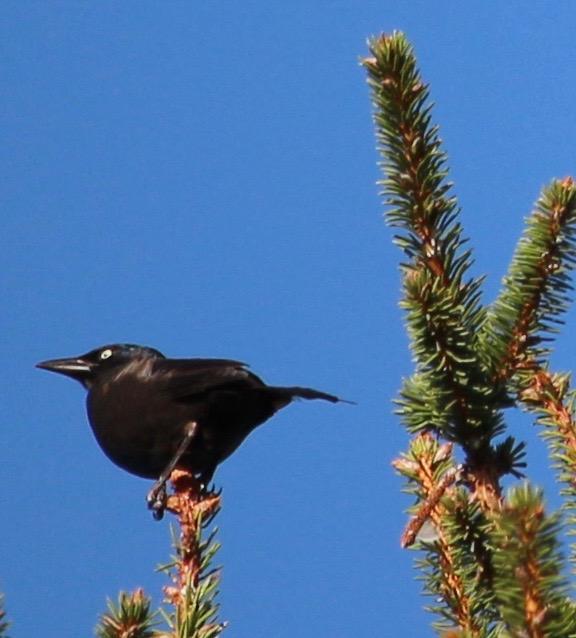
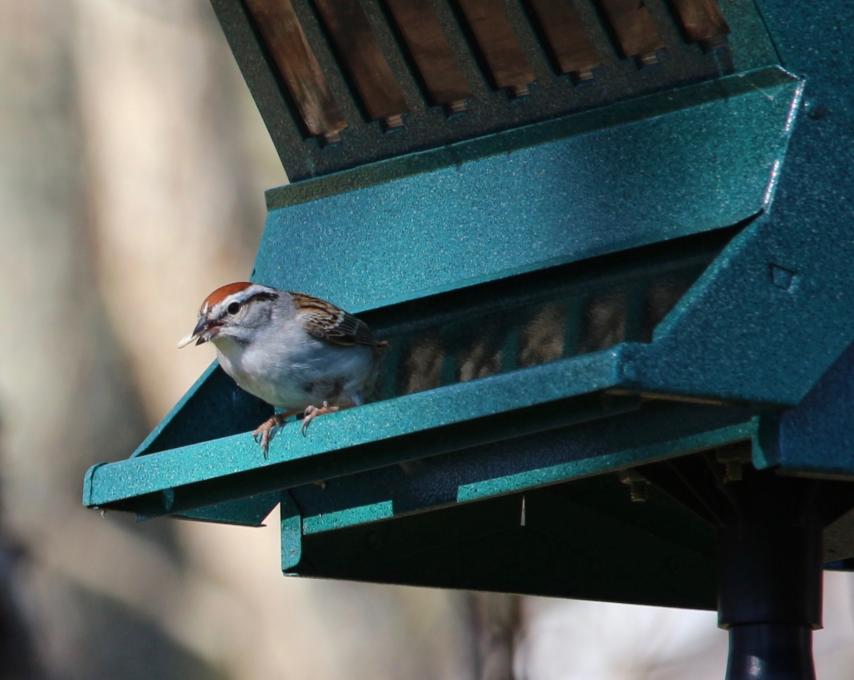 quick grab and go at the sunflower feeder. I can watch the chickadee as it approaches from nearby tree branches, and then swiftly returns (but not as swiftly as the sparrows). The sparrows, on the other hand, more particularly the song sparrow, will also drop down to the ground to continue feeding on any spillage or other things. Fun to watch the white breasted nut hatch hop down and up vertically. The downy woodpecker at my suet feeder is quite shy to movement or noise ... he/she (I have had both) seem in no hurry to fly off, unless they catch a movement from me or a noise. There is a male cardinal that seems (my imagination?) in charge of letting the rest of the bird world know what is happenning in my yard. He and the she as well, do't seem to frequent the feeders much, but he is often perched on the outside shower or somewhere else int he yard, and seems to call out after I have added seed, etc. Activity 3: songs - I love the songs, I have become more awake to the different songs and calls (albeit realizing that sometimes quite different melodies may be from the same bird-song) but I have realized that song memory is very difficult for me. OH - but, as I love to watch the hunting birds, some time ago I learned to be alert for mobbing and watch the skies - for the emergencence of a hawk being mobbed etc
quick grab and go at the sunflower feeder. I can watch the chickadee as it approaches from nearby tree branches, and then swiftly returns (but not as swiftly as the sparrows). The sparrows, on the other hand, more particularly the song sparrow, will also drop down to the ground to continue feeding on any spillage or other things. Fun to watch the white breasted nut hatch hop down and up vertically. The downy woodpecker at my suet feeder is quite shy to movement or noise ... he/she (I have had both) seem in no hurry to fly off, unless they catch a movement from me or a noise. There is a male cardinal that seems (my imagination?) in charge of letting the rest of the bird world know what is happenning in my yard. He and the she as well, do't seem to frequent the feeders much, but he is often perched on the outside shower or somewhere else int he yard, and seems to call out after I have added seed, etc. Activity 3: songs - I love the songs, I have become more awake to the different songs and calls (albeit realizing that sometimes quite different melodies may be from the same bird-song) but I have realized that song memory is very difficult for me. OH - but, as I love to watch the hunting birds, some time ago I learned to be alert for mobbing and watch the skies - for the emergencence of a hawk being mobbed etc 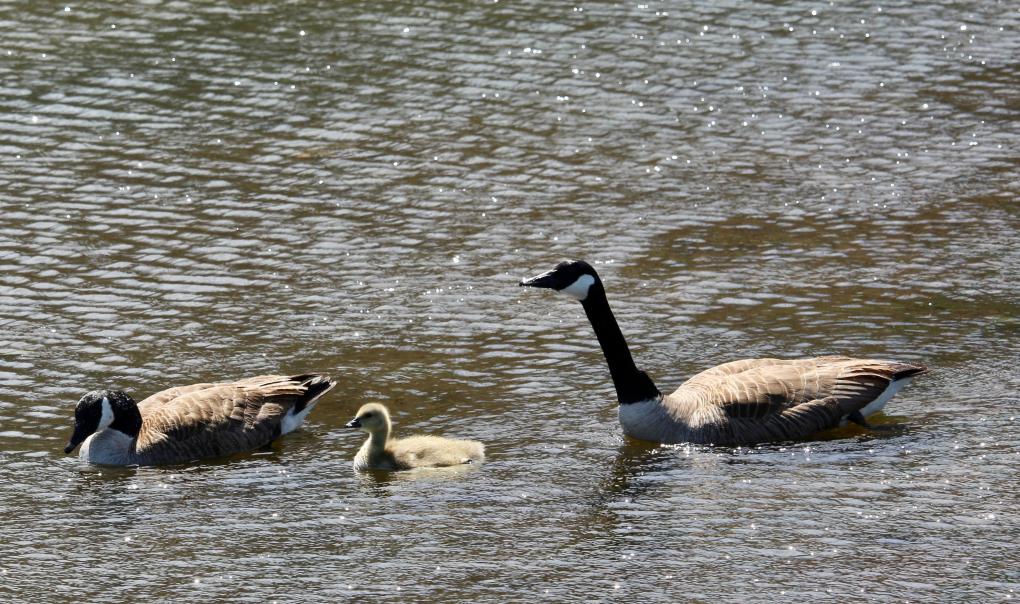

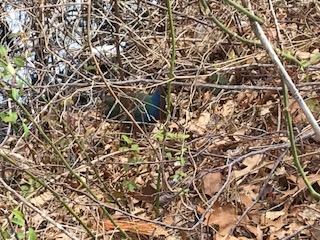
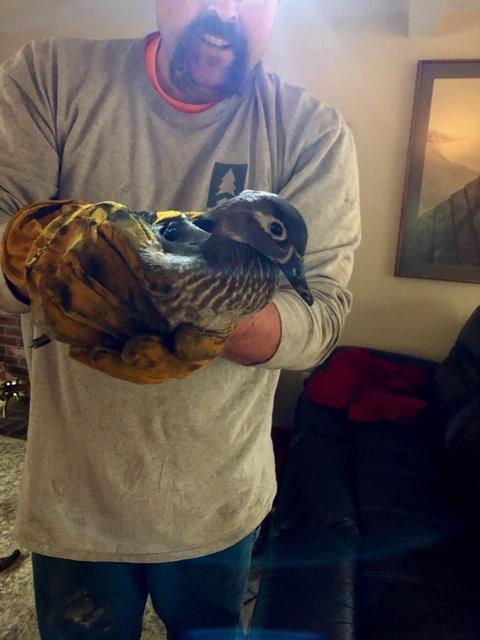 I learned about the Wood Duck, when my son - in Brewster, MA - on Cape Cod, MA in USA rescued this female from the bottom of his chimney on Saturday after 3 days of mysterious noises. Duck was not what they imagined. I discovered that uniquely these ducks have claws, as well, for securely being in trees. This also reinforced to me the need to look at both mail and female pictures to identify a bird (you can tell I am a novice), as the make Wood Duck has a wildly colorful head. Their house is on the edge of a woods, with wetland behind and a small pond about 200 yards away. (And the men in our area seem to be cultivating very wierd mustaches during the pandemic).
I learned about the Wood Duck, when my son - in Brewster, MA - on Cape Cod, MA in USA rescued this female from the bottom of his chimney on Saturday after 3 days of mysterious noises. Duck was not what they imagined. I discovered that uniquely these ducks have claws, as well, for securely being in trees. This also reinforced to me the need to look at both mail and female pictures to identify a bird (you can tell I am a novice), as the make Wood Duck has a wildly colorful head. Their house is on the edge of a woods, with wetland behind and a small pond about 200 yards away. (And the men in our area seem to be cultivating very wierd mustaches during the pandemic).